Last updated 12 Mar 2024
Here I write some things about peppers, with a sprinkle of other veggies. I've started learning the art and craft of horticulture in late 2021, and every season mucking around in soil, among greenery, has been one of my life's greatest joys. I don't track every inch or fruit obsessively, nor do I take dozens of pictures each week - quite the opposite. I think it’s just like houseplants – the more you leave them alone and not stare at them most of the day, the better.
The first year – 2022 – was my first growing season ever, and I experimented a lot with plants other than peppers (tomatoes, basil, parsley, cress, rosemary, chives, green onions). I would try regrowing basil, developing a nice rosemary plant, growing them from seed… generally just testing the waters and learning as I went on.
The findings and conclusions I drew allowed me to make adjustments for the 2023 season, by which time I was hooked on horticulture. I developed a more strategic approach to growing, based on research I did on planting times, seed germination, pruning, as well a bit about soil. This resulted in a great season and a bountiful harvest in all of the plants.
For the third year – 2024 – I felt that I have some of the horticultural know-how down to a tee, so I’d like to kick back and try out new plants as well as new varieties. One aspect that I’m trying to focus on is the longevity of some of the plants (sadly, not peppers or basil – those are not tolerant of my climate and will not be perennial plants).
I’m not a professional – I grow things for fun and like to play around with different variables to make my plants grow better. Ideally, I strive for stronger plants and better yields – everyone should – but I’m not into hydroponics or a super-scientific approach to absolutely maximize fruit production. Just a kid, a few pots, and a dream! Rather, I treat it as a relaxing hobby and let the plants flourish, helping them how I can along the way. Whether you plan on growing from seed, or you can’t be bothered and would rather get a nice starter plant from a local nursery, I hope you enjoy the text and that it may provide some tips on growing some beautiful, spicy peppers!
Here’s a bit about my climate and that your mileage may vary greatly. Some said it’s hard to grow hot peppers in my climate without a growbox, greenhouse or UV lights; after my first season I failed to see the difficulties. It is possible! Peppers can be grown even in Alaska!
The climate could be summed up like this: USDA 6-7, winters are a hit or miss (one period of winter can be mild with a few freezing days, another can be snowy with below 0 Celsius, and another can be mild except for March where it snows all month.) The same goes for summer – we’ve had a notably mild summer in 2022 and I wonder if that was a big factor in that year’s harvest. The summer of 2023 was great, if not a bit dry.
Sometimes we get temperature spikes in late winter and early spring, which can be disastrous for some plants that stay outside over the winter. Similarly, it’s not unusual for April or even May to have a few snowy days! Long periods of overcast skies in early spring are detrimental as well; they produce leggy plants early in their growing season and that’s generally suboptimal for when you have a “mild” but surprise-filled growing season like in here.
Then, after the summer, the temperature and sunlight gradually drops as fall comes, and this season tends to bring a lot of rain, overcast skies, and temperature spikes. These can extend right to December, even January. As such, by the time September comes around, plants are bolting and peppers (tomatoes too) shed leaves and you can see they just want the fruits to come mature before they wilt. My friend tried to overwinter a pepper (a bog-standard chili I gave her in 2023) but to no avail. My aunt insists that she had a decorative pepper variety back in the day that would grow beautifully for many years – perhaps next season I’ll confirm it myself.
I write all this to hammer in the point that the tips and strategies I use may not apply to the growing conditions you have. Starting early in a warmer climate will leave you with bolted plants much too early, and unless you want your, say, peppers in April, be my guest – but know that this may result in low fruit yields or even undesirable characteristics of the fruit if you don’t consider fertilizing, UV lights, pot sizes, and temperatures (for peppers, environmental conditions are a key part of their capsaicin content apart from a given cultivar’s genetics). I’m no pro, but my best advice is to 1) read about it, and 2) just try it yourself and see what fits you and your growing conditions! In my view, there’s just as much fun in growing as in harvesting, if not more.
We all gotta start somewhere, right? I had been into houseplants for some time, but I can’t put my finger on what convinced me to jump into horticulture. Not that that was the brightest of ideas, since I lived in a tiny apartment with suboptimal window placement… but back in the fall of 2021 I was trying to cook healthier and use more ingredients. That naturally brought me to basil, as it’s such a versatile and popular herb to use. I think that was the spark – I wanted to simply have more basil, and before long I had watched a few videos on propagating basil. It was loads of fun, and it worked! Not satisfied enough with what I had, soon I got a rosemary plant, then a thyme plant, and then – just as December rolled around – during a phone call my mom suggested growing what I want and just having fun, whereas my brother suggested hot peppers. I was hooked, but I was also very new to growing from seed; thus, I read and researched, and decided to give it a shot despite the conditions – from what I’ve read online, I would still be able to grow them, just not as bushy and big with less fruit. Fine! To hedge myself against the potential disappointment, I also decided to try growing tomatoes, basil, parsley, cress, chives (from seed), and green onions (from bulbs).
The peppers I picked were: jalapeños (I wanted to grow them and nothing could stop me), pepperoncinis, cayenne peppers, and chili seeds taken out from a random store-bought chili. I began germinating the seeds in the beginning of February. Following advice found on the Internet, the seeds were soaked in water for about a day before planting into one of those small plastic greenhouse trays. I had heard from a tomato-growing friend that germinating seeds in a paper towel using a plastic container is a great way to test the seeds; I did that with tomatoes and was very satisfied with the results. The other herbs and plants (apart from green onions) were planted around the month of March.

(Tomato sprouts germinated using the towel method provide a high germination rate!)
None of the cayennes sprouted; in general, I felt that all the pepper seeds had trouble growing once they sprouted. I blame this on my inexperience! No, but really – I knew something was up; they were on an eastern-facing window in a block of flats, so they might have not gotten enough sunlight. Another fact to swallow is that I didn’t listen to the plants that much – I was late with repotting into bigger pots, I didn’t pinch the flowers, I didn’t fertilize them enough… I can blame myself or use this as experience. I prefer the latter.


(Left: This is how the seedlings looked like on 14 March. Right: And this is how they're doing 2 weeks later.)
I deeply regret that I didn’t take more pics of the peppers growing; by the time May rolled around I decided that since I will be moving in the summer I might as well just move them to my parents’ garden full-time. Over the summer I didn’t come around as much, but I was being reassured that the peppers are fine, and as they produced fruits, they would be picked – and they were good! It was a pretty good result for my first real horticultural adventure.
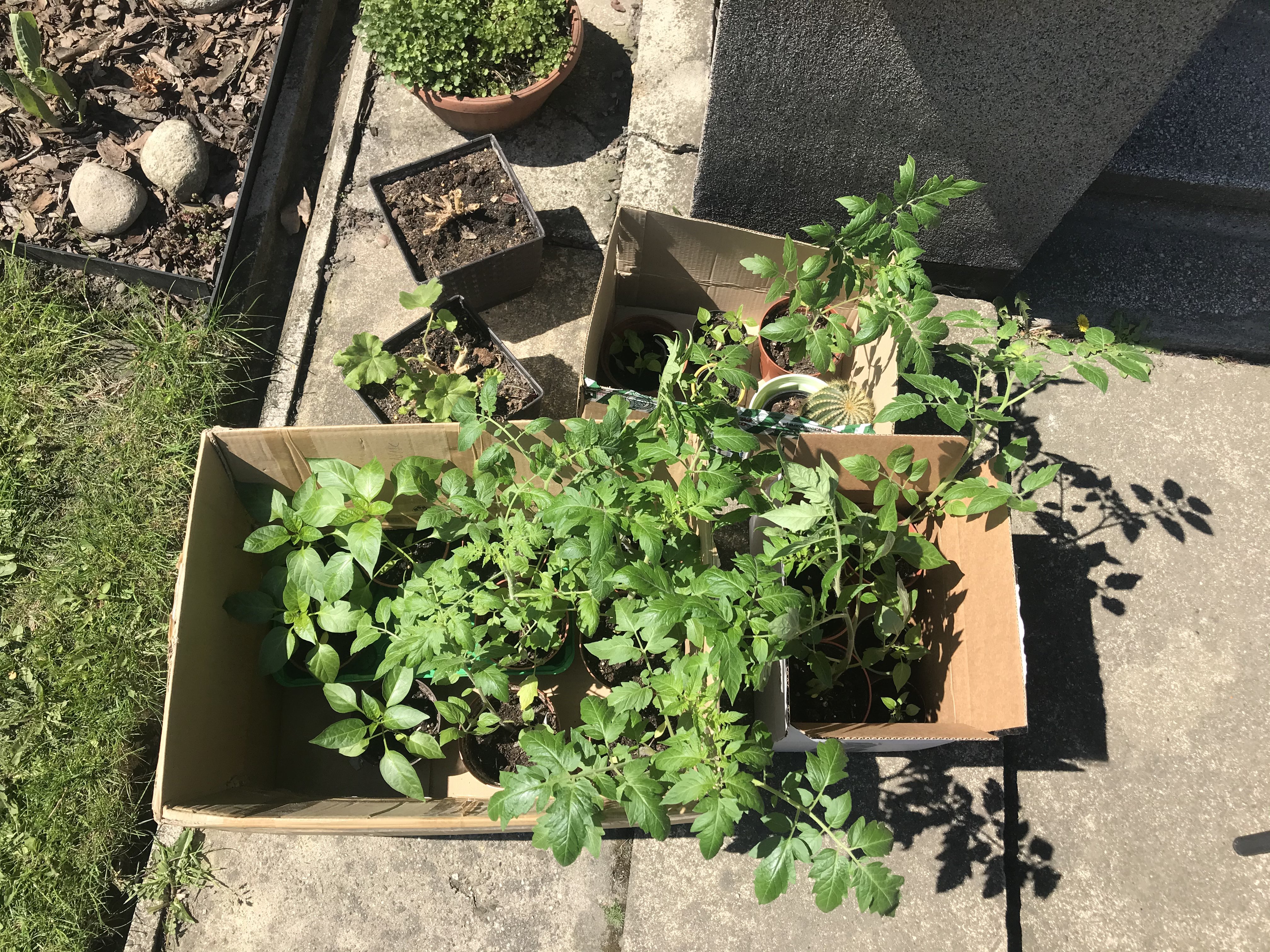
(5 May - before giving them off to my parents' garden)
The power of hindsight allows me to say I’ve made a couple of mistakes – small pots, not enough light, and not pruning the plants were the most “jarring”. People in the know know that if you leave a plant alone, it’ll grow, sure, but if you want to have proper results, you need to step up your game. I spent the latter part of the season satisfied, but wanting more. For the next one, I wanted to prepare a plan.
The first adjustment that had to be done was the germination method and timing. The peppers had to be started sooner – last year’s plants were still flowering and producing fruit by October! The plants’ growth is being hampered by streaks of colder, more overcast, rainy days, so ideally, you want to align the lifecycle of a plant with the period of best growing conditions; so by all measures that means I gotta start as early as possible. Germinating peppers in February is too late for the climate I live in, even if the Internet says otherwise. I began germination on the second of January, using a method I’ve experienced is miles better than steeping seeds in water.
Germination – this is one of the topics that everybody has a stance on that they’ll gallantly defend. Some steep the seeds in water (softening the seed shell), some do it in chamomile tea (which is antiseptic, or something), some put them straight to soil… dear God, just don’t put whole chillies in the ground as some videos suggest!
The old “trick” with the paper towel my friend told me worked wonders with tomatoes, so I figured that it’s worth a try for the peppers. Here’s how it works: you place a few seeds onto a paper towel, you moisten the towel rather liberally, you put the towel into a plastic food container (or any container that provides a seal and won’t get wet), sprinkle the container lightly, cover tightly, and place in a dark, warm spot. In my case, I put the seeds into a games box I had next to the heater for a week.

(Crappy picture, but this is how I germinate. Couple of seeds in a couple of wet paper towels - and seal them off for a week)
The conditions you create by this are miles better than the standard method of planting them directly to a mini greenhouse; as a result, the seeds not only germinate much quicker, but you can literally see which seeds are the most viable, which are dead, and which are weaker. After a week, you open the container, unfold the towel, and pick out the strongest sprouts. One bit of advice is to be extra careful – plants sprouted that way tend to bury into the layers of the paper towel and “stick” to it. I found that moistening the towel liberally, using tweezers, and a bit of patience works best. If you break a sprout, no worries – you got 10 more seeds to try! That’s another thing about this method I love. For this season, I picked all the seeds and put them all together in one bigger box.
If you spend a Saturday afternoon on seed prepping and if you plant many seeds at once, including planting into soil, be extra careful not to accidentally put any bits of soil into the box. This will result in a blooming mold, and may result in wasted seeds. Keep it clean and sterile as you can; clean the tweezers after planting into soil. Speaking of mold, I noticed in my tests that the seeds are best germinated during a period of 7-10 days – checking after the 7th day, and if the seeds are slow to sprout, an additional sprinkle of water and leaving them for a couple more days – but not too long! After 10 days I noticed many more mold spots on the towels across all seed containers. Mind you, if a variety is super slow to sprout (14+ days) try it out on a couple of seeds, but have a second option ready.
Second, the choice of the peppers. Some germinate and reach maturity earlier, some later. The hotter the pepper is, the slower it seems to grow. That being said, yes, it is possible to grow a ghost pepper in a colder climate – you just might not get as much a yield as you would do in a warmer area. Yes, of course, you can use heating mats and UV lighting… if you wish. I don’t want to, but if you do, more power to you.
Okay, now that’s done, here are the weapons of choice: jalapeños from the seeds of last year’s fruit; fresh pepperoncini seeds, fresh de cayenne seeds, and three sets of standard chilis from last year’s fruit – the random seeds from store-bought chilis produced red, green, and yellow fruit – I picked each of the fruit and planted separately. I have no scientific explanation for this, just a sliver of hope that I get fruit of all three colors ;) They did seem to be pretty strong plants last year, and were grown locally (if you can call a place about 500 kilometers away “local”), so this was based on the hope that they are accustomed somehow to less warm climates. Oh yeah, and my brother got some habanadas – habaneros without the heat – but he decided to grow them himself without my aid. I still gave him advice.

(This is the mini-greenhouse I use for sowing and germinating some of my plants)
After a week, on the 9th of January, I opened the container, picked out the strongest-looking seeds and filled a mini-greenhouse with the seedlings. As well as a few pots, because I can’t let seeds go! To me, the sight of seeds waking up with life is too good to pass up, thus it hurts me to just throw all the other seeds away. I admit to not being able to accept to decimate my seedlings. Sorry. It’s better to sow more than less, sure, but it’s also better to just pick a few hopefuls unless you have space for all the plants – so I came up with a brilliant scheme which I highly recommend: give the rest away. When the time comes, give out as many plants as you can – to friends, to family, even put them out in a corridor if you want. Ignite the joy of horticulture in other people! That way you don’t feel bad about throwing the plants out, and strategically, it makes perfect sense – you get to choose the best seeds during germination and then, as the seedlings grow, you can pick out the best ones and leave the rest (which undoubtedly will also be good plants) for other folks to grow. As of 2024, it’s the second time I do this, and people take the seedlings like hotcakes.

(Freshly planted!)
The position of the pots and the mini-greenhouse were also adjusted from last year; this season they were placed in a southern-facing window in a pretty warm area of the house, above a heater (in other words, in my living room, hence I didn’t want heating mats and UV light). Big switch, much more sunlight, and a higher room temperature, but lower humidity – something to be aware of. Apart from using a humidifier, I sprinkled the clear plastic lid of the mini-greenhouse almost daily, and covered the potted seedlings with plastic bags that I made holes in and sprinkled as well. It’s a good idea to get a humidity and temperature monitor and place it near the place where you grow the plants – I use a cheap Xiaomi thingy that cost me about 15$ and it works perfect for my use case.
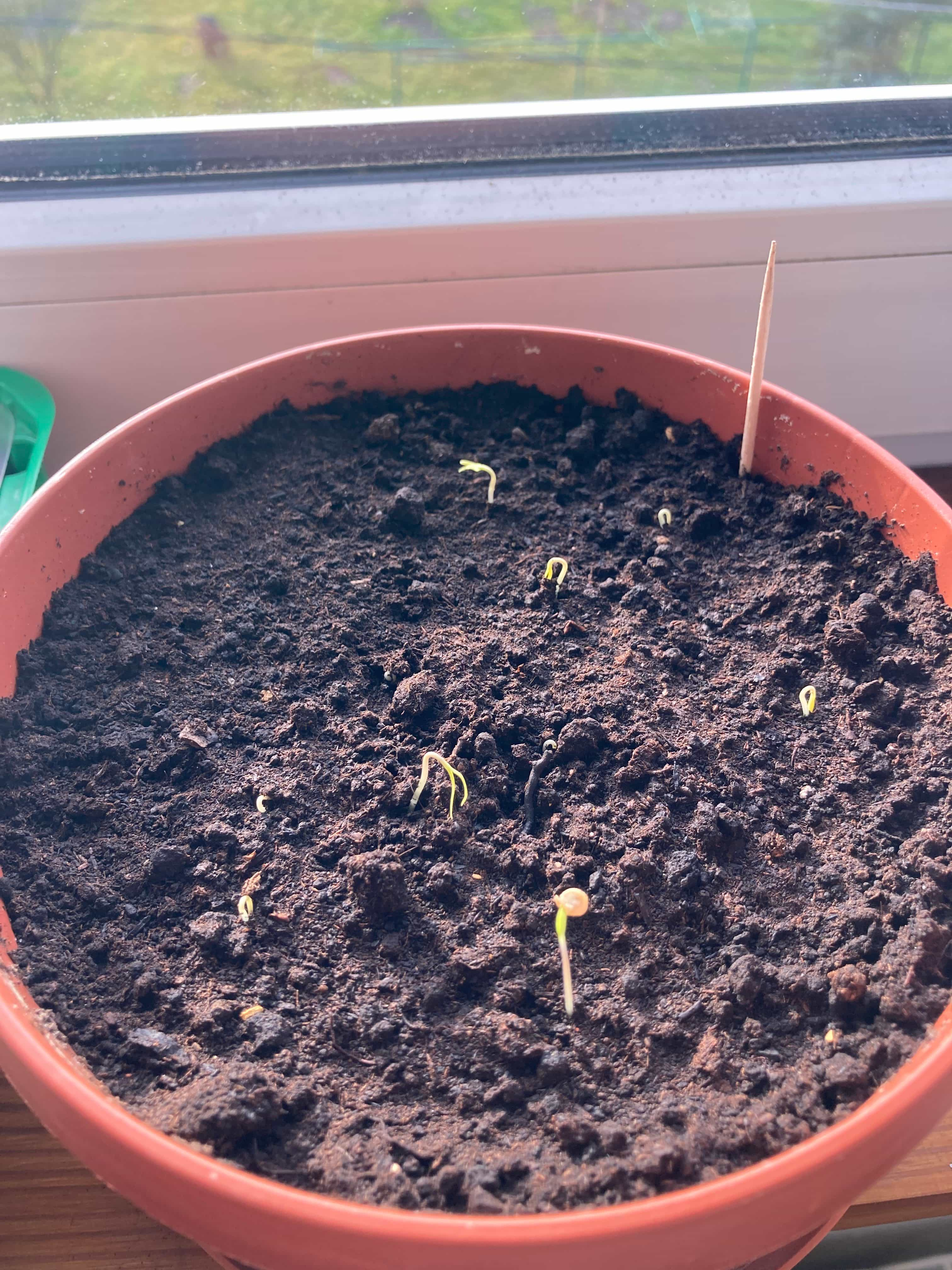
(16 Jan: Something’s happening!)
I watered and waited until the seedlings reached the top of the greenhouse’s plastic lid, being mindful to rotate the greenhouse so the plants grow a bit more up and less to the side. Around mid-March they reached the lid, so it was high time to replant them as likely their roots have begun coiling. Peppers are top-heavy plants and they need to build a nice root system to support the weight of the fruit; if you don’t give them space early, this will impact later growth of your plants. I replanted individual pepper plants into 4-5 inch pots and gave the rest away. Watered, covered with plastic bags same as earlier, and left them to do their thing.
You might find that after some time the peppers start drooping, or bending to one side. I think this is rather normal, especially in a colder, less sunlighty climate during this time of year – they bend to the sunlight, and their root system is still developing; as such, it can’t support the weight of the spurting seedlings. That’s an easy fix – tie the pepper to a skewer or some thin stick.
In the beginning of April, I began to see the first flower buds. The plants want to flower, but they still smol! What do? Pinch each and every flower bud as soon as you see them. Now’s not the time for flowering, but for growth – they can flower and produce fruit when they’re nice and settled into the final planting place. Pinching flower buds doesn’t hurt the plant; in fact, it helps it redirect its energy where we want it to – the roots and the upper structure. Some say it doesn’t matter much since the flowers generally tend to fall off before the plant is “ready” to start producing fruit – well, yes, but still, they need some energy and nutrients to flower and I’d rather have them save it for actual growing. Plus, it’s time well spent on tending to plants rather than just watching them! I take it that since I started them earlier, they will flower earlier – they still had room to grow and I made sure that the growing conditions are good. In other cases, such early flowering might be a sign that the plant isn’t doing all that well and wants to pass the next generation before the conditions get too bad. In that case, well, check your conditions – temperature, humidity, cold drafts, or roots sticking out of the bottom. “Listen to your plants”, I’d say.
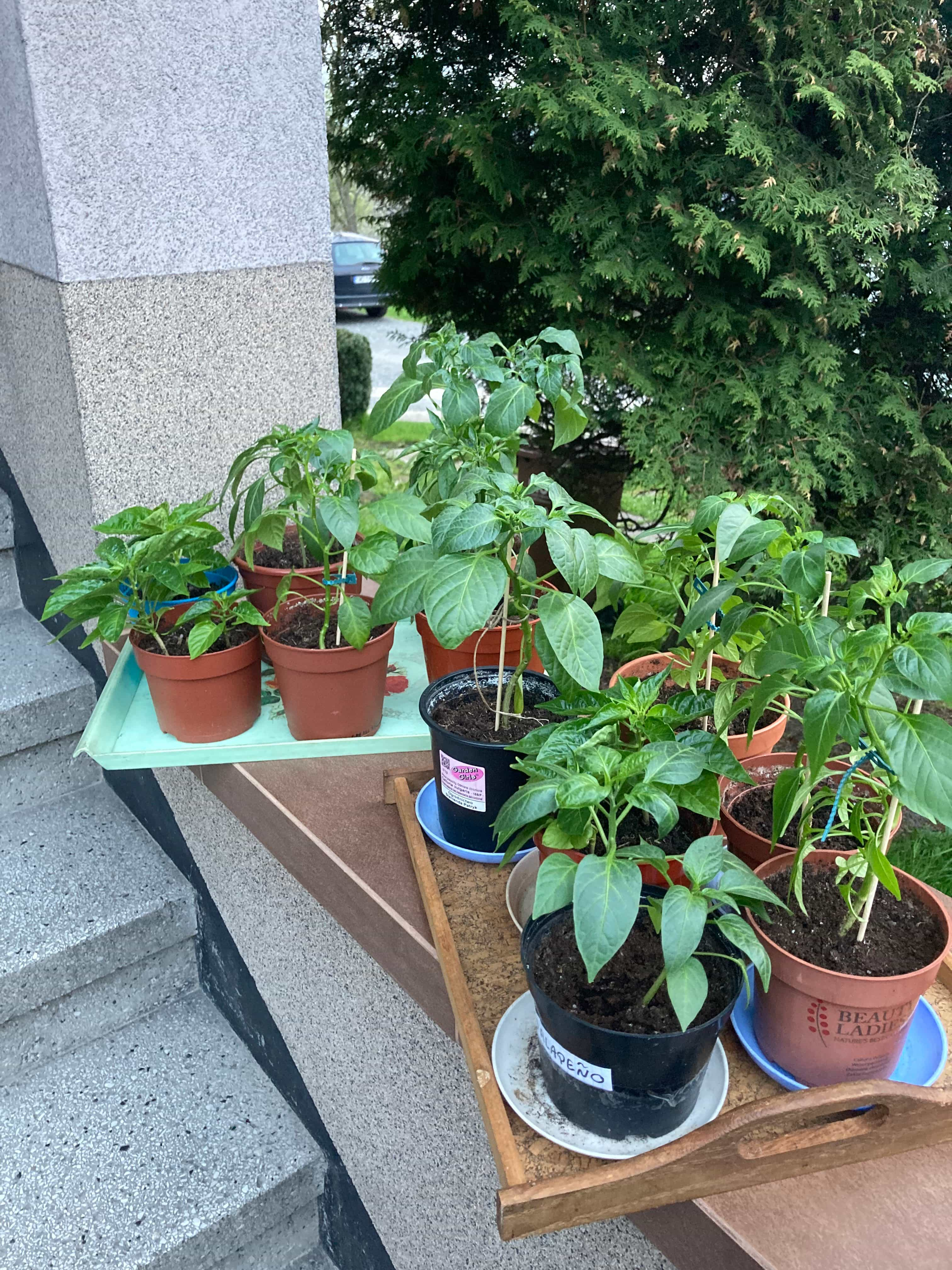
(mid-April state of the peppers)
Here’s how my peppers looked by mid-April – very solid, strong structure, and I already began to put them outside on warmer days. They look fit to be planted outside soon. Time to think about that.
I got myself a planter box from old Euro-pallets. Lined it with agro crop cover, made some drainage holes on the bottom with a drill, and filled it with soil. Peppers like soil that’s rich in nutrients and which pH is on the upper scale, i.e. 6.0-7.5 – similar to many other plants. I got the most fitting soil I could find (5.5-7.0 pH) and mixed it with organic compost from my composter. I also added some nitrogen fertilizer, being careful not to overdo it, as peppers can react to nitrogen so well that they’ll grow too quick. Which might not be that good a thing. This is a big change from the 2022 season, given that I only used the largest pots I had around and filled them with randomo soil, happily emptying the bags without a care for nutrients or the soil’s acidity.
Come mid-May, the spring freezes are gone – the peppers are in the planters. In hindsight, I could have done more spacing between individual plants, especially in the planter box, but I ran out of pots and couldn’t pass up on the two beautiful pepperoncini plants – so I planted them kind of in the middle. The two peppers in the white pot are the jalapeños, which grew slower than the rest, and the big clay pot contains my brother’s habanadas – they’re his thing, I let him do whatever he wants despite trying to advise that they’re too cramped. Please disregard the mess around – I felt it was the best place for the planter, and all that junk was going to be thrown out around fall that year.
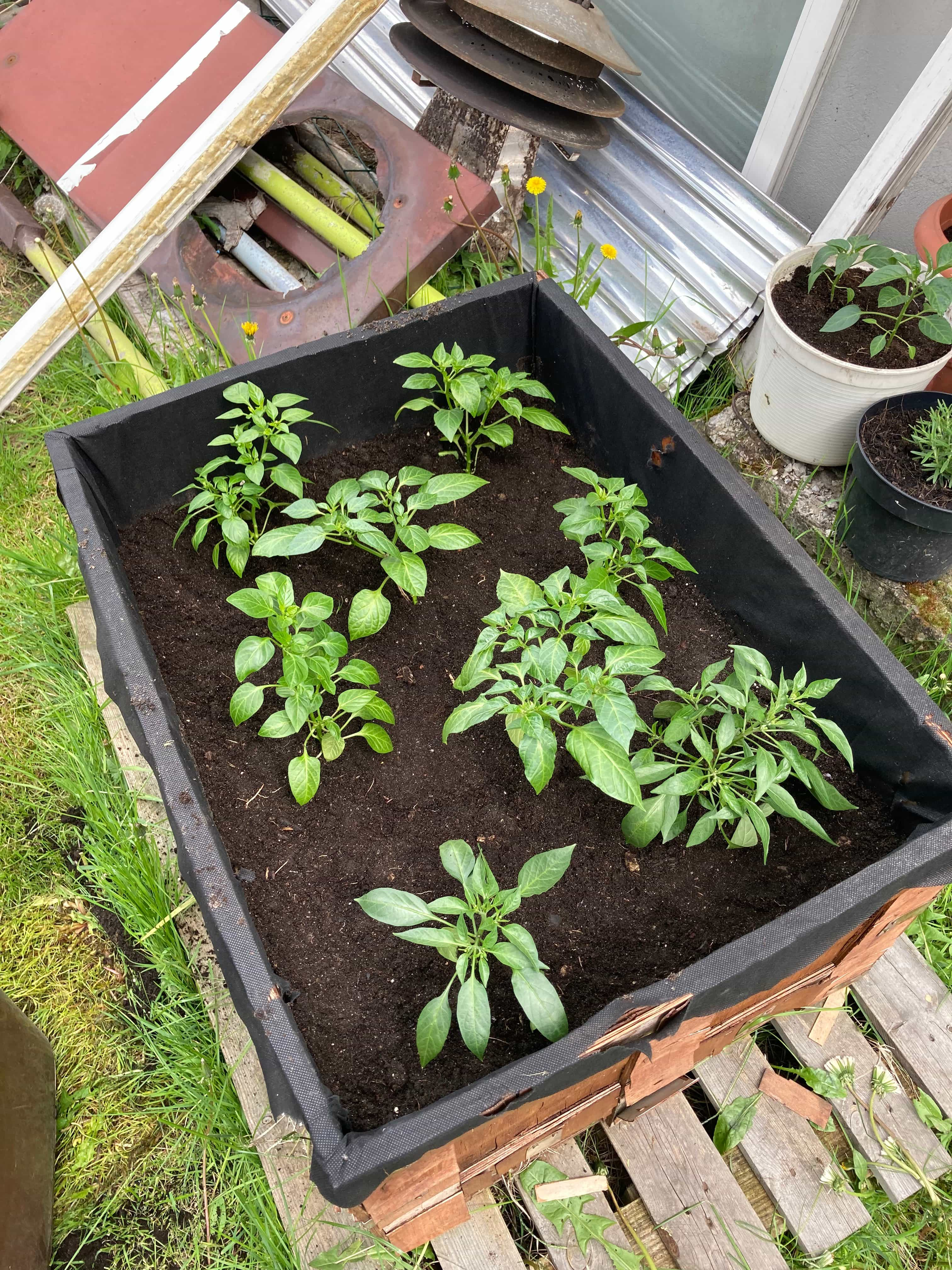
(16 May: peppers are permanently outside.)

(What didn't fit in the planter box got moved to bigger pots.)
Removing flower buds and planting the pepper in a better place with better soil did WONDERS! The plants looked markedly happier, stronger, and bushier. By mid-June, once the peppers had settled nicely outside, per advice from the Internet I decided to prune some of the plants – gosh, it’s such a contentious topic! While many say it does help, and there is indeed research done, others adamantly refuse to prune, saying it’s counterintuitive. I honestly didn’t know better, so I pruned the leggier plants since I had two of each variety. A nice haircut. Whether it will helped a plant that is an annual in my climate zone… I’m not that sure, honestly! I find that by the time I decided to pick all the peppers in September the pruned plants were bushier, yes, but only the pepperoncinos and yellow chillis showed better yields. My guess is that with the growing seasons I have, chopping the top off slows the plants too much; that is, unless I’ll try to prune them earlier in the season, when they’re still in their initial pots.

(22 June: Around this time I stopped all pruning and let these lovelies grow out)
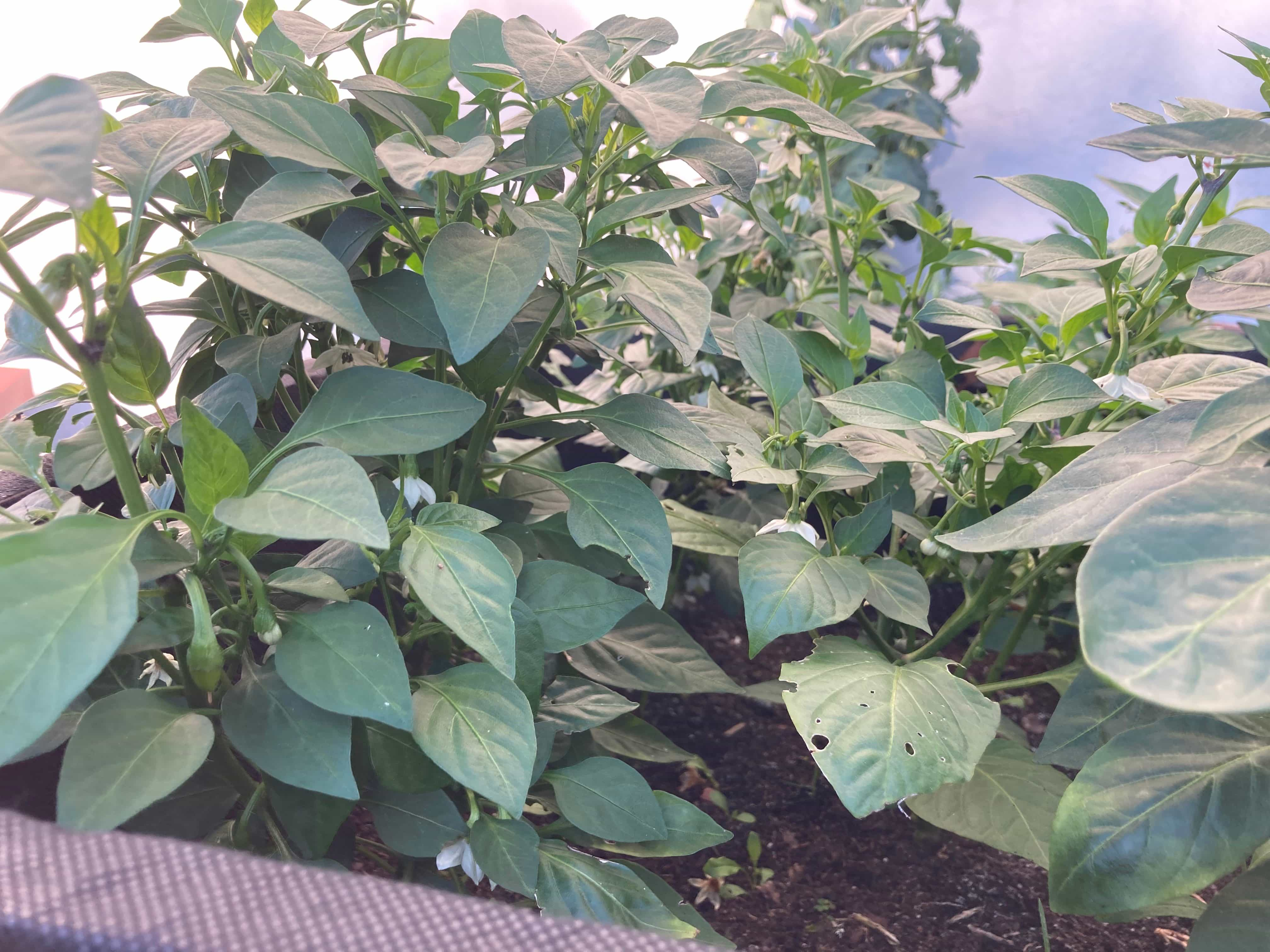
(Some snails chewed on the leaves, but it’s nothing. You can see where the plants were pruned, and first fruits are also visible.)
July, August and September is the time to harvest. I’m super glad that all these adjustments made it so that my peppers had lots of fruit at around the same time – between August and September – and the yield was much, much, much more plentiful! I’m talking about around 4-5 kilos of all peppers, rough total. The habanadas were the slowest growers and didn’t produce that much fruit, but, my gosh, the fruit! Incredibly curious, exotic, pungent flavor. Me and my brother decided grab all the peppers in a few rounds and do something other than just eat them fresh: make pickled peppers, and make a hot sauce! First time doing one, and I went with a lacto-fermented base of hot peppers, then doing two batches of pineapple & pear, and mango & habanada purees. Blend the base with some of the ferment water to thin the sauce out, then mix the base with the purees, bring to a boiling point, add a bit of vinegar, pour into jars and pasteurize. The result is a funky, pungent, sweet and sour sauce with loads of different flavors popping up and a nice back heat. Amazing stuff! The pineapple & pear sauce is less spicy, whereas the mango & habanada one is less sweet. We got a solid 1,5 kilos of sauce, and we put them into big jars (for us to enjoy) and tiny 50ml jars to give out to friends. It was a hit!
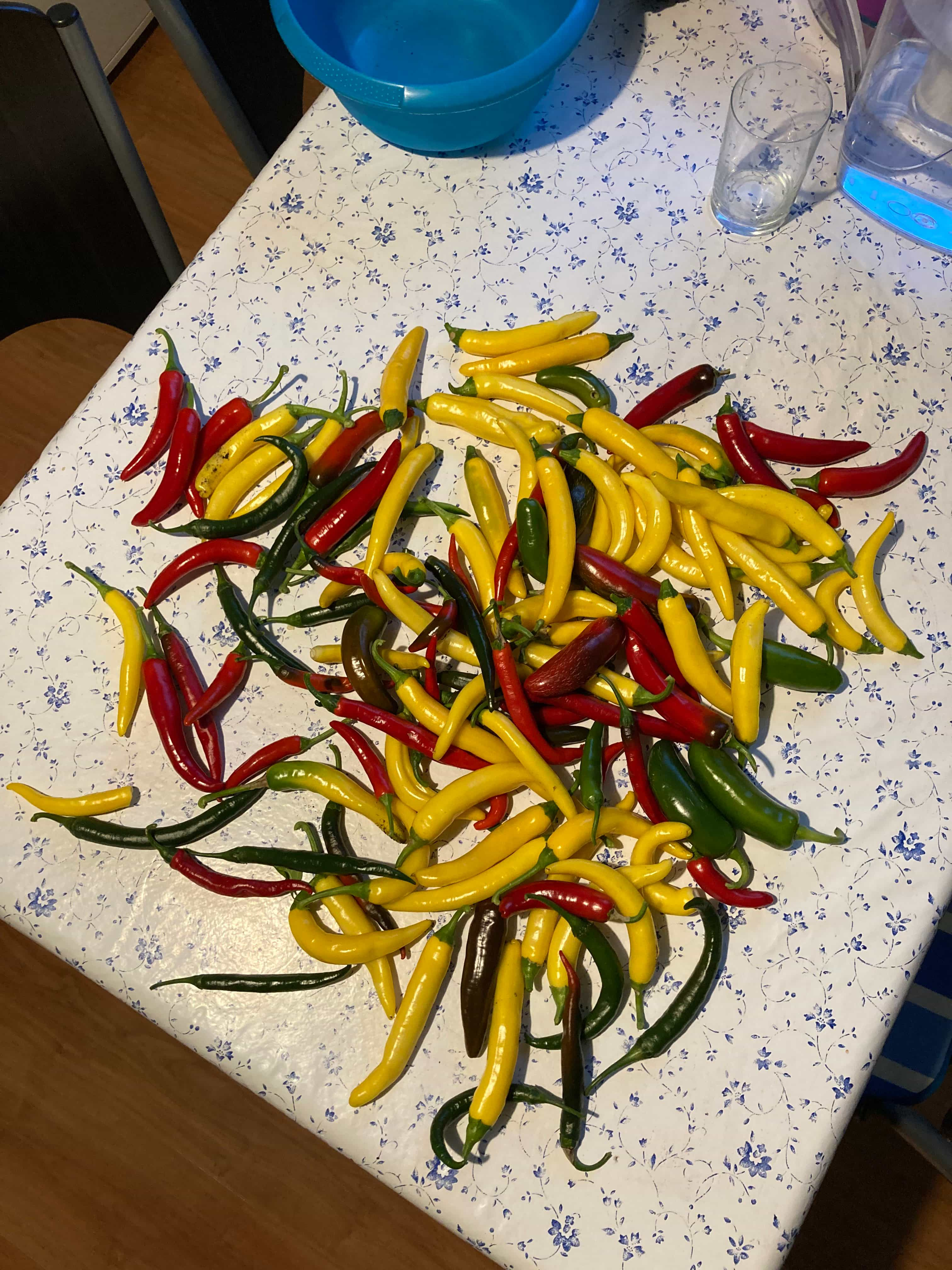

(One of the few harvests I managed to do while picking such a big amount of peppers at once. Chillis, cayennes, and a few jalapeños, and the sauces made from them! Sorry for the poor quality pics.)
With the 2023 growing season coming to a close, allow me to share some pics of other things I had been growing:

(Green onions, parsley, dill, 3 types of basil, sage, and winter savory on June 26. The ladders have been placed so that our pup doesn't hop into the planter - she did so many times)
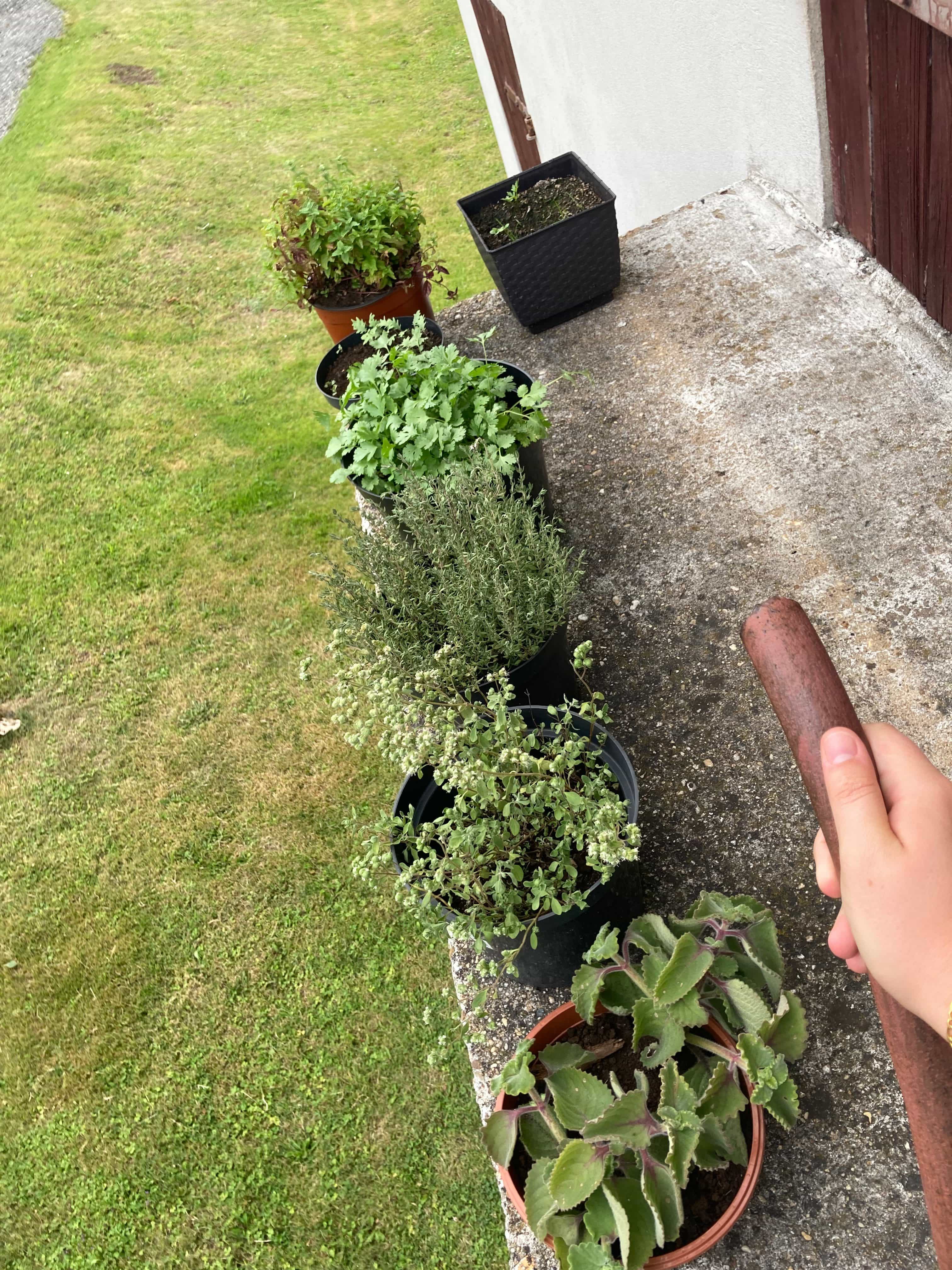
(30 July, from the top: lovage that was eaten by snails, mint that’s overexposed to the sun, kale sprouts, cilantro, thyme, bolting marjoram, and “Cuban oregano” (Coleus amboinicus) just hanging out on an elevation)

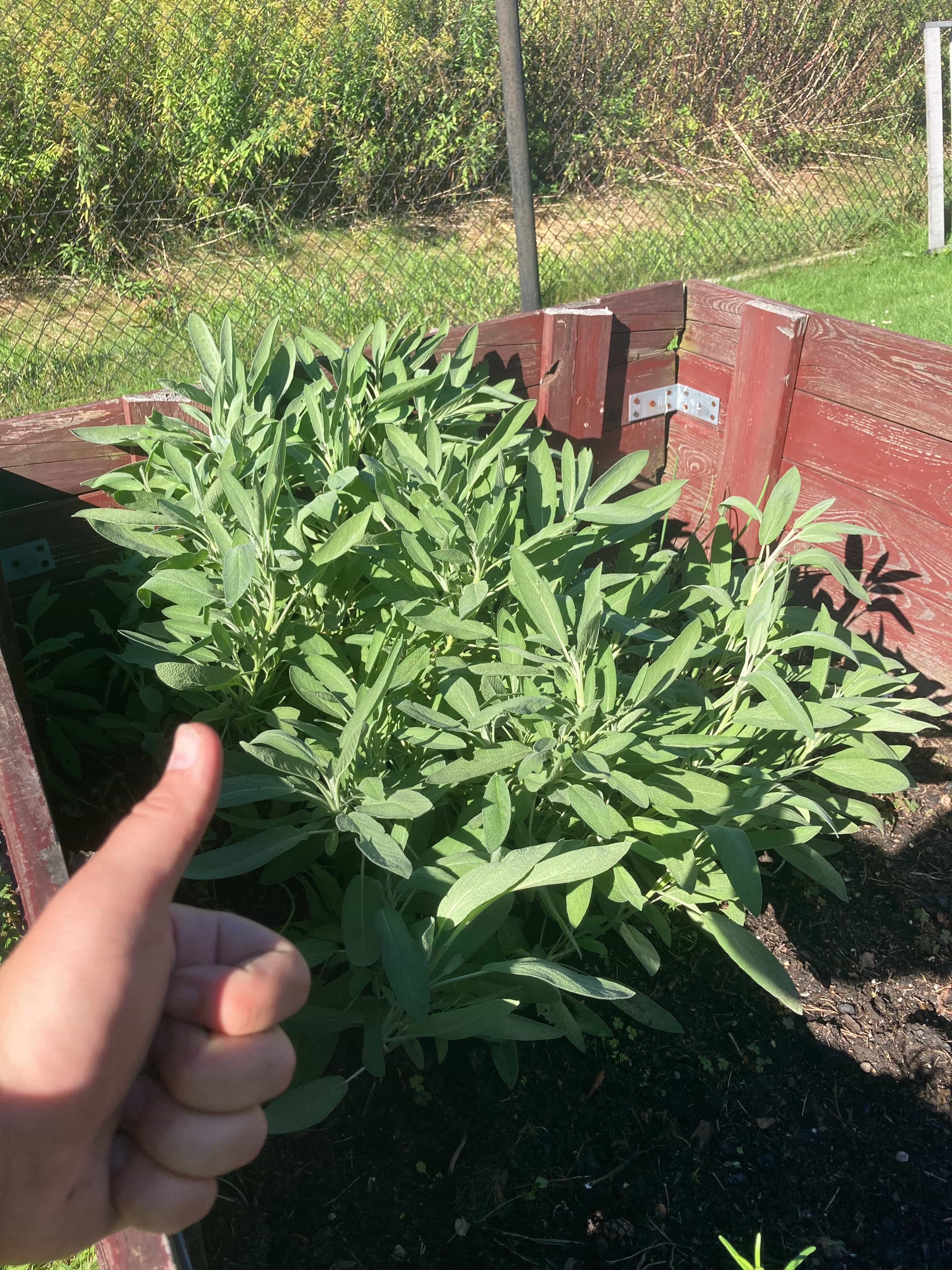
(Basil harvest on 23 Aug and a monstrous sage on 20 Sep, just before harvest – all from seed!)
That’s it! On to the next year ;)
What’s in store for 2024? More changes! This year I’m trying some new varieties – just plain old curiosity. I initially thought about splitting the selection in two – some of the seeds would be ideally the best for my climate (Hungarian yellow wax hot, Cyklon chili, Bulgarian carrot pepper), while some would be ones that I just wanted to try (Poblano, Serrano, Peter pepper). I spoke with my brother and left the selection up to him. I only made it clear that I don’t care about the heat that much and I would love some new cultivars to try. Hey, if anything goes wrong, I still have some pickled chillis and a few jars of my hot sauce from last year! ;)
There’s another aspect to the selection worth considering. Many of the seeds planted for 2023 were seeds from last season’s fruits, and having seen them grow, I suspect they might have cross-pollinated, given that some fruits didn’t really fit their description. I threw out all the seeds I had except the habanada seeds I collected from one fruit.
So, which varieties did I go with this year?
Most of the growing process I’m gonna plan after the 2023 season as it gave me very good results in plant growth and fruit amount, with three adjustments. The first one is giving the plants even more space – 4 in the planter box, 3 in separate, big pots. Alternatively, I might add a tomato to the centre of the planter box – we’ll see. The second one is the pruning – not only am I going to give all the plants a haircut, I’m also going to do it much earlier, even before I start to bring them outside. Lastly, I’m moving the germination one week backwards (starting 27th of December) in schedule just to see how this affects the overall growing specs of the peppers.
As the season is developing, I’m gonna add text and pictures on the fly. What I’m most curious of is whether I can align the peppers’ lifecycles even more to the growing season; by pruning them in early April (maybe a bit later, we’ll see how they go) I might slow them down to the point where they will start bouncing back just in time for the first really warm days. That’s why I started germinating one week earlier just to be extra sure.
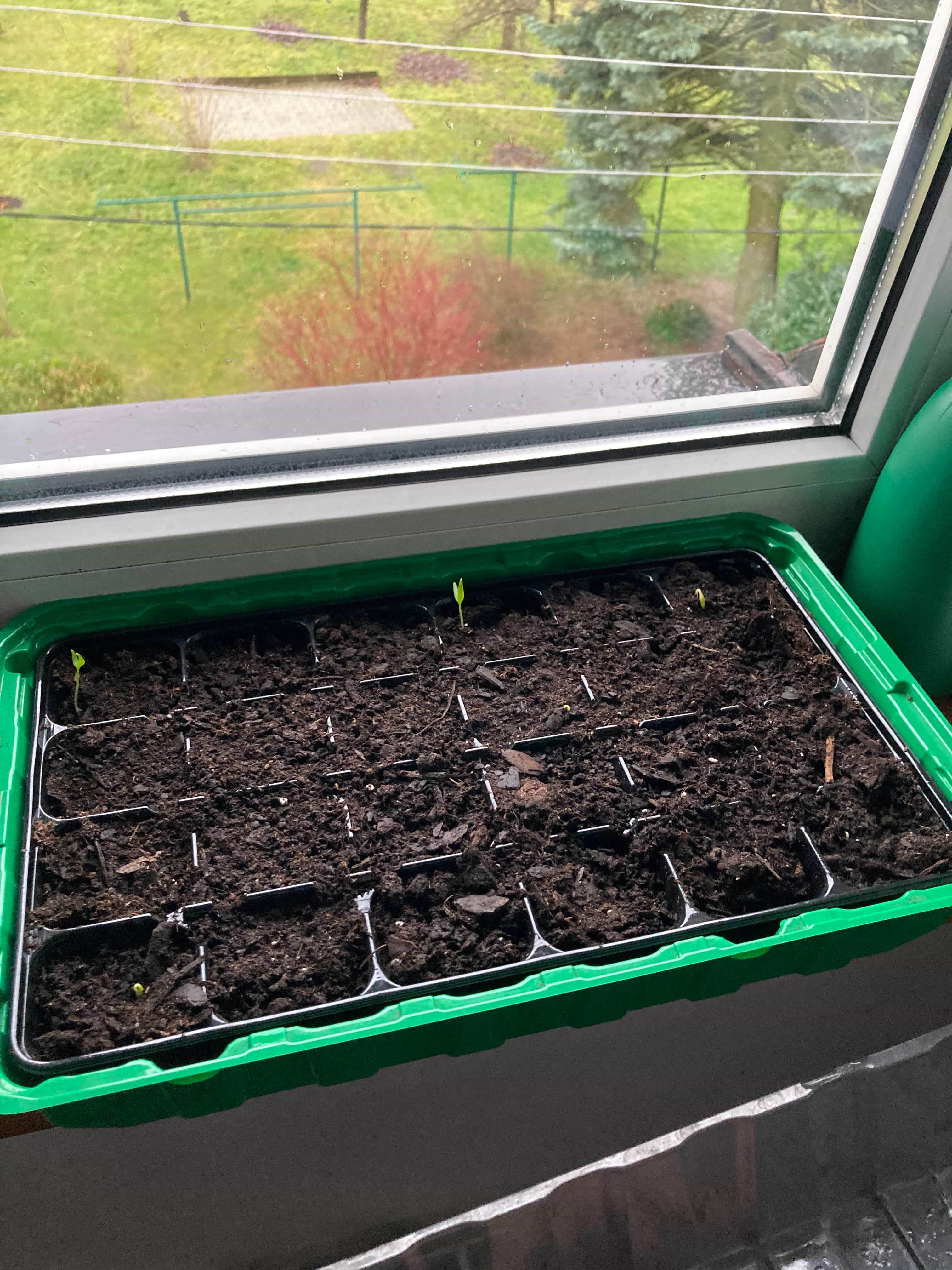
2 Jan 2024: the peppers are out of the towels and planted in the mini-greenhouse. No mold on the towels this time, thankfully, and out of 5-6 seeds germinated every one of every variety sprouted nicely! Except the habanada. I left the habanadas for a few days longer and no dice – the seeds seemed unbothered by my attempts to wake them up; ultimately, as mold began to grow, I fished out just two seeds that seemed to have any sign of life inside (a little puffed up, white rootlet barely visible inside the seed). Now, I’m not sure whether it’s a matter of the seeds being plain weak from the last generation (or the fruit which I scooped the seeds out of being picked too early), or whether this cultivar just doesn’t produce viable seeds onto the next generation (despite it being stabilized without GMO, an all-natural marvel of pepper breeding. I just couldn’t find the info on re-growing this variety), but this one was a sad sight, really. I’m gonna hold on dearly to those two seeds to see what comes out of them!
2 Mar 2024: Time to repot! I was rushing the repotting which I deeply regret and didn’t snap a photo freshly after repotting. I chose the same pots as last year (4-5 inch in diameter) and picked out one of each variety. All the seedlings look solid and the roots did not coil in the mini-greenhouse – nice!
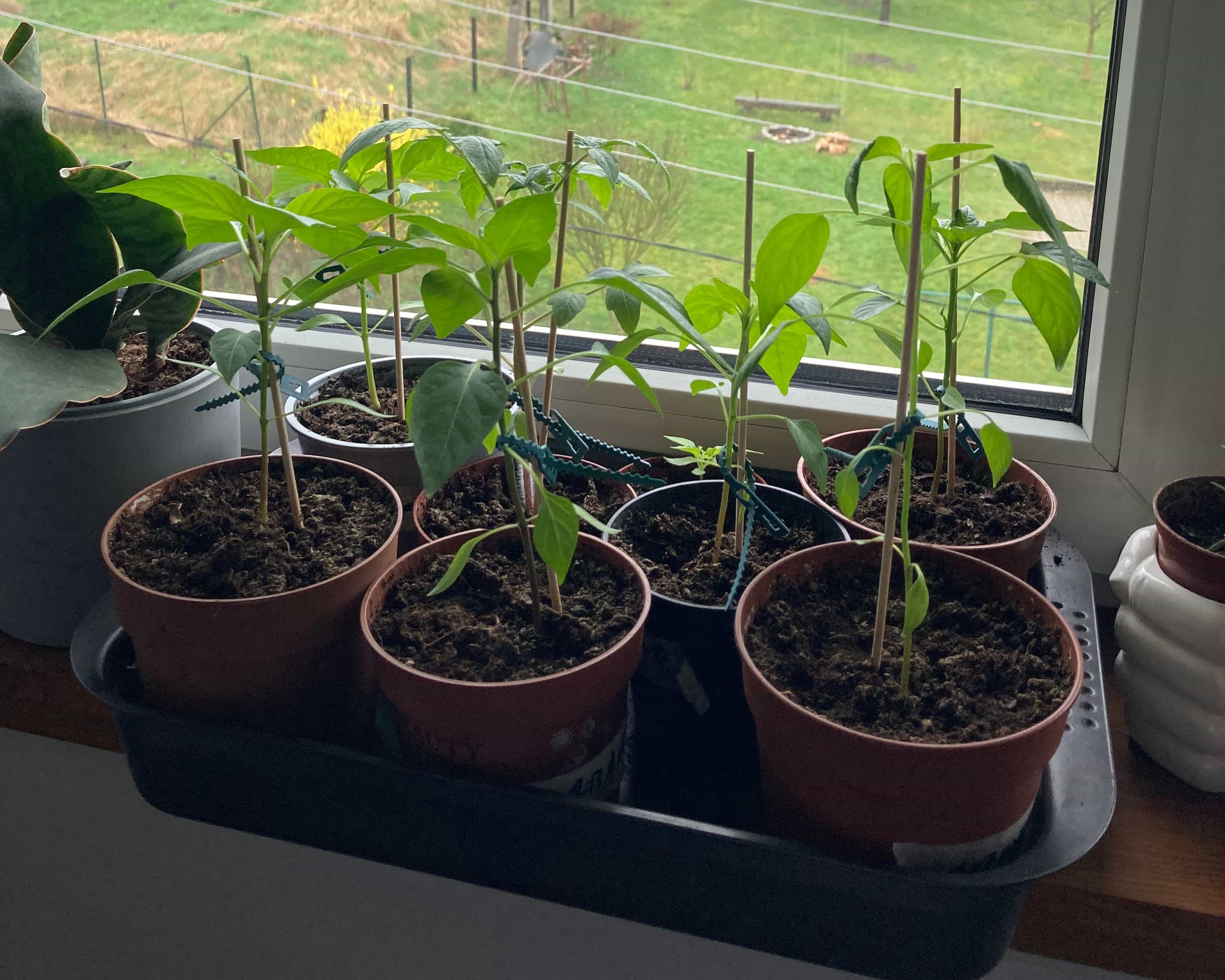
12 Mar 2024: The peppers had exploded in growth, so much in fact that I can spot a few flower buds going to appear soon! They’re looking solid, if not leggy – this can be attributed to two things: one, these aren’t the varieties I’m used to seeing, so they might appear a little too big or too stretched for the growth stage; or two – the beginning of March was very, very warm, a breath of spring, but the last week has been horrid and the peppers might have hoped that the warm streak would be the onset of spring proper.
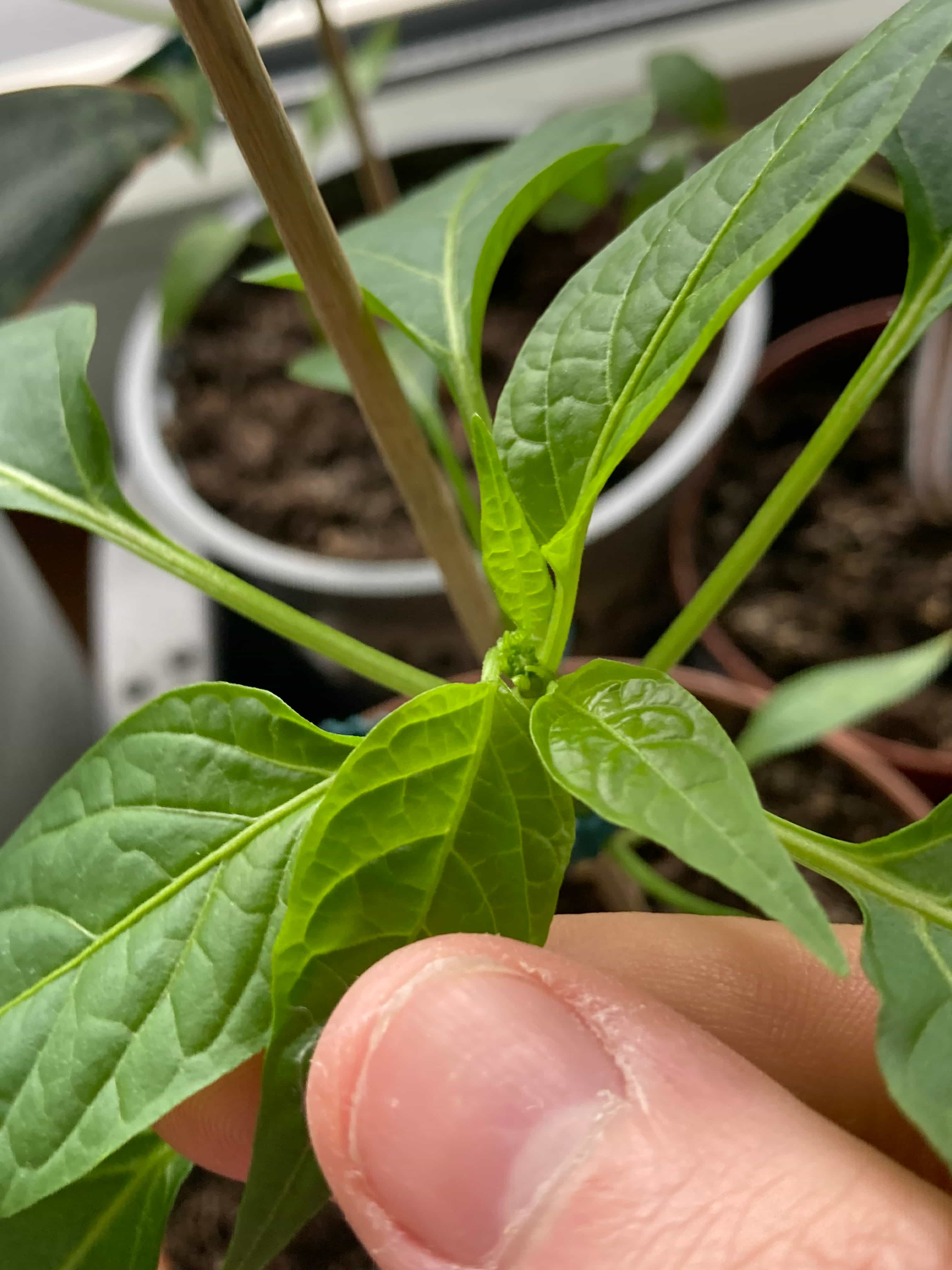
I’m thinking that at this stage if they continue to stretch or pop flower buds, I’m going to prune them at the end of March. We shall see. I get the feeling that the plants are maladjusted to the weather at this stage. In addition, I’m thinking of repotting them to even larger pots and potting them deeper, as some of the plants already begin to stick their roots out of the pots. Of note is the poor growth on the habanada – last year was pretty similar in terms of its growth, but still, compared to the others – even the chocolate habanero, which is monstrous – it looks stunted.